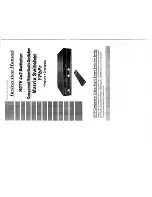
Making Network Connections
Hubs are designed to link multiple workstations and other hubs
to an Ethernet network.
Directly
Hubs can be joined directly to other network devices via their
front-panel ports as long as both devices have one port with an
identical connector.
For example, the TigerStack 3312TA with its twelve 10BASE-T
ports and a slide-in BNC module can be:
• cascaded to a LAN switch or another 10BASE-T hub via one
of its two uplink (twisted-pair, switch-selectable crossover)
ports
• connected to a 10BASE-T adapter via one of its fixed
crossover ports
• cascaded to SMC’s TigerHub
™
FL6, since they each have a
BNC port
• attached directly to a thin coax backbone via its BNC port
Via Transceiver
If both devices have an AUI (Attachment Unit Interface) port
(designated by the IEEE as the standard interface for 10 Mbps
Ethernet networks), they may be joined with two identical
transceivers* and a length of the appropriate type of cable.
For example, the TigerStack 3306BC hub (with its six BNC
ports, one AUI port, and one 10BASE-T port) can be:
• cascaded to another TigerStack 3306BC hub with two fiber
transceivers that are joined with a fiber link segment, to span
the distance between two buildings
*
Transceivers are typically 2-port devices with one AUI connector and
one connector for a specific medium (RJ-45 for twisted pair, BNC for thin
coax, or ST for fiber).
18
C
ONNECTING
Содержание TigerStack
Страница 25: ...Stacking the Hubs INSTALLING 14 ...
Страница 48: ...Status Diagnostic LEDs 38 Testing the Installation 41 CHAPTER 5 TROUBLESHOOTING 37 ...
Страница 53: ...42 ...
Страница 75: ...64 ...
















































